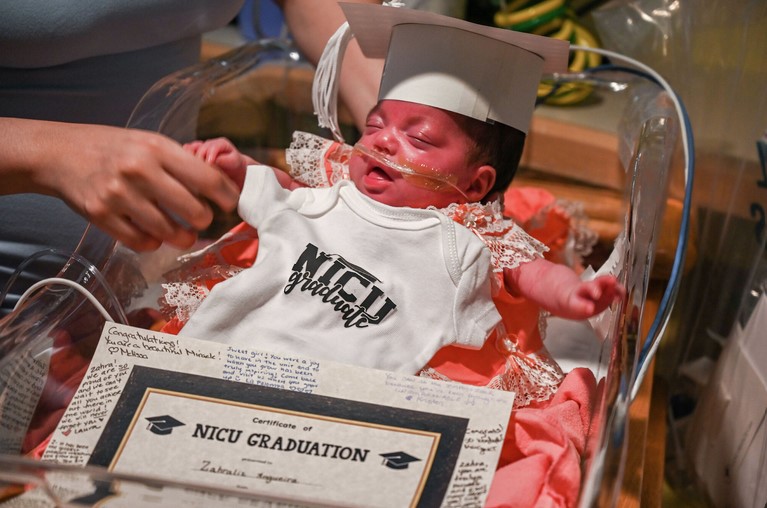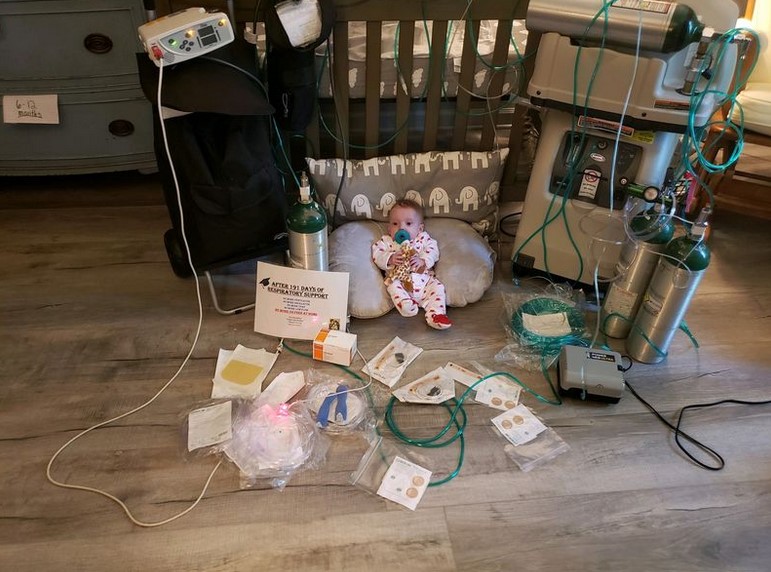From the moment your premature infant is admitted to the NICU, one of your most pressing questions for the NICU team often revolves around the timing of your baby’s eventual discharge home. Instead of focusing on a specific weight or age in days your doctor may often discuss discharge criteria based on your infant reaching specific milestones including
While you might have initially been informed that most premature infants tend to reach developmental milestones around your due date of 40 weeks of pregnancy, the reality is that an increasing number of NICU infants are being discharged weeks before their due date with weights significantly lower than those of full-term babies. This shift is occurring because more NICU infants are now receiving treatments and therapies that were previously exclusively administered within the confines of a hospital setting.

While you might have initially been informed that most premature infants tend to reach developmental milestones around your due date of 40 weeks of pregnancy, the reality is that an increasing number of NICU infants are being discharged weeks before their due date with weights significantly lower than those of full-term babies. This shift is occurring because more NICU infants are now receiving treatments and therapies that were previously exclusively administered within the confines of a hospital setting.

To offer a clearer picture, consider a recent study encompassing more than 8200 premature infants across 115 NICUs within the Pediatrix neonatal network. This study revealed a striking trend: among infants with chronic lung disease—a condition that necessitates oxygen support even at 36 weeks of corrected age—a significant 65% were being discharged with oxygen therapy therapy.

The increasing practice of discharging NICU graduates with oxygen stems from emerging data indicating that the rates of hospital readmissions for infants sent home with oxygen are comparable to those without oxygen. This is underscored by a comprehensive study involving 3500 infants affected by chronic lung disease. Remarkably, this study demonstrated a consistent 34% hospital readmission rate across both groups: the 53% of infants discharged with oxygen and the 47% without oxygen, signifying that the presence of oxygen therapy does not significantly impact the likelihood of hospital readmissions. Nonetheless, it is important to recognize that the study’s findings reveal an alarmingly high rate of hospital readmissions of 1 in 3 infants with chronic lung disease underlining the vulnerability of these delicate infants, irrespective of whether they were initially discharged with or without oxygen support.
While the notion of taking your infant home with oxygen might evoke concerns, you can be reassured that a study that evaluated parents’ preferences between being discharged from the NICU with oxygen or waiting until their infant outgrows their reliance on oxygen, demonstrated that a significant number of parents, in hindsight, express a preference for the former option—being sent home earlier with oxygen.
The study’s authors aptly conclude that fostering an early educational process to enhance parents’ familiarity and comfort with home oxygen and associated technology can serve to streamline NICU discharge planning. This not only acknowledges the potential anxieties associated with taking a child home on oxygen but also underscores the importance of providing parents with the information and tools needed to navigate this aspect of post-NICU life.

Typically the most challenging milestone for premature infants to achieve—and the one that frequently extends their NICU stay the longest—is the ability to consume full feedings unaided by a nasal-gastric (NG) tube. Mastering the intricate coordination of suck, swallow, and breathe mechanisms essential for synchronized eating and breathing demands the development of refined fine motor skills and this learning process takes time. An apt analogy can be drawn to the experience of learning to chew gum and walk. Each of these actions can be managed individually, yet the true challenge lies in successfully coordinating both activities simultaneously.

In the past, when premature infants surpassed their due dates without achieving mature suck-swallow abilities, they were often considered candidates for a surgical gastric tube. This intervention was deemed necessary to facilitate their discharge from the hospital, under the assumption that they might never acquire the essential skills for safe bottle feeding. However, this practice is rapidly becoming less commonplace as newer research reveals that infants sent home with nasal-gastric (NG) tubes experience fewer visits to the emergency room and reduced hospital readmissions when compared to infants with surgical gastric tubes. Moreover, a significant number of these infants smoothly transition to full oral feedings as time progresses.
Using an NG tube for your infant is like having training wheels on a bicycle. Just as training wheels provide essential stability in the beginning and are slowly removed over time, having an NG tube for your infant serves a crucial purpose. With time, as learning progresses, these training wheels can be removed—some infants simply adapt more swiftly than others.
As succinctly stated by the American Academy of Pediatrics in their policy statement regarding Hospital Discharge of the High Risk Neonate “The decision of when to discharge an infant from the hospital after a stay in the NICU is complex” This sentiment underscores the intricacies involved in determining the appropriate time for a premature infant’s discharge.
The challenge for caregivers of premature infants stems from the complexity of accurately pinpointing the moment when these milestones are reached. Furthermore, even if these milestones are attained for a specific duration, the potential for regression remains, potentially necessitating renewed support such as oxygen or NG feedings. In healthcare practice, if this technique of milestone based required discharge were to truly work it should logically result in readmission rates similar to those of full-term infants. This is in stark contrast to the present reality where almost one in three NICU graduates encounter a hospital readmission. Clearly, improved tools are needed to support former premature infants successfully transition from the NICU to home.

Firstday Healthcare was created by Neonatologists with the aim of extending the care provided in the NICU into the comfort of parent’s homes, facilitating a safer and more gradual transition to post-NICU life. Our proprietary technology platform integrates FDA-approved wireless medical-grade vital sign sensors combined with the continuous support of our dedicated 24/7 neonatal healthcare providers, who actively monitor infants’ vital signs and offer guidance for any inquiries or concerns parents may have, day or night. Firstday Healthcare empowers parents to become proactive partners in their infants’ health, equipping them with essential tools and data to ensure optimal outcomes for their precious newborns.
Copyright © 2023 Firstday.healthcare